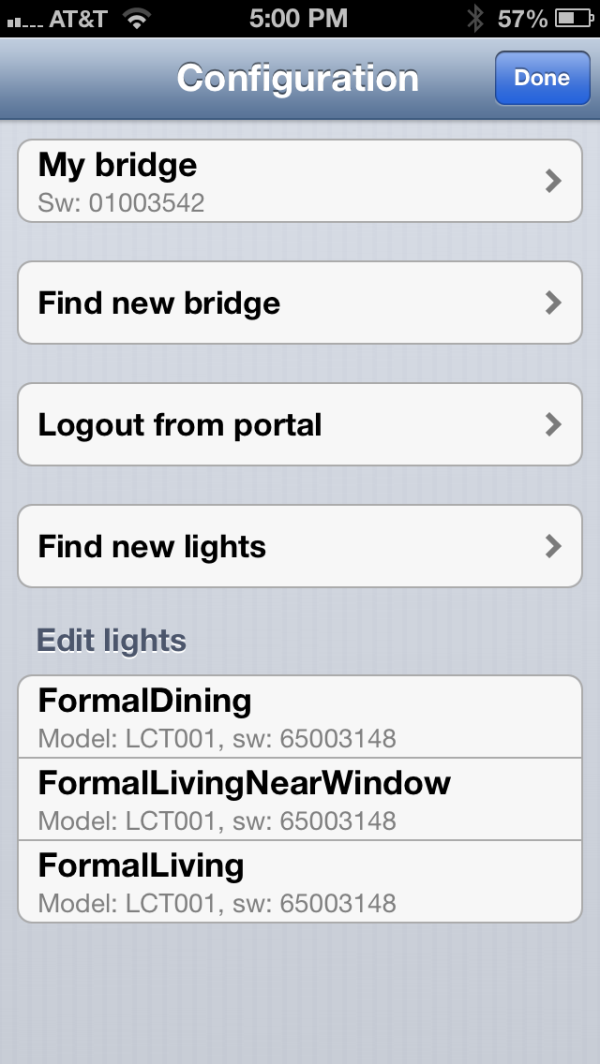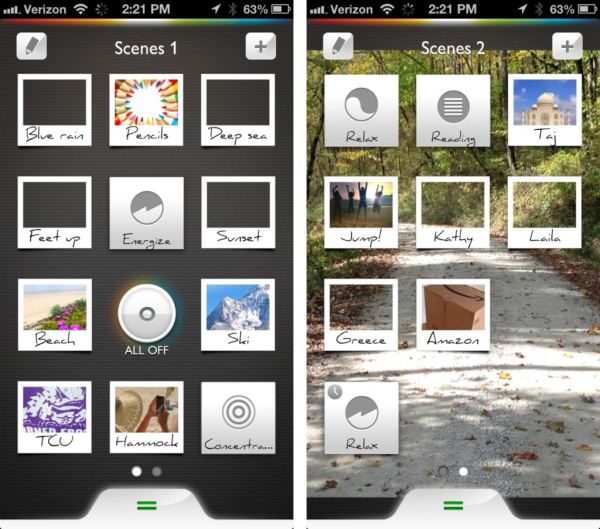Philips Hue: Automated Home Lighting Gets Colorful
by Ashu Joshi on March 1, 2013 12:50 AM EST- Posted in
- Gadgets
- Home Automation
- Philips
- Hue
- Lighting
Philips Hue Setup
The setup process is very easy and at no point do you need a PC or a Mac computer—everything can be done using a Smartphone or a Tablet. The first step for any automation controller that can be controlled over the Home Network or Internet is to get it on the Network, naturally. Philips makes this easy by sticking with Ethernet for the Hue Bridge.
As far as the setup procedure, the first step is to screw in the Connected Bulbs and turn them on. All the bulbs turn on just like normal light bulbs, with a default white light. Once all the bulbs are screwed in and powered on, plug the Hue Bridge into an Ethernet port connected to your home router/gateway and apply power.
The Hue Bridge boots in less than 20 seconds (you can see the boot process in this short video). The next step is to install the app from the Apple App Store on your iOS device (or the Google Play Store for Android).At this point, make sure that your smartphone WiFi is on and connected to your home network. Fire up the app and it will instruct you to press the “link” button on the controller. When you press the button the app discovers the Hue Bridge and you should be ready to go. In my case, it automatically discovered all the three bulbs and they showed up in the app.
From the App settings section it’s possible to rename each bulb to give it a meaningful location. To help with this process, when you select one of the bulbs in the app the corresponding physical bulb starts blinking to show you which light you’re adjusting. This is a handy feature for the initial setup, and it could be even more important if you happen to have a lot of Connected Bulbs.
The app comes with multiple scenes that set the lighting ambience to predefined levels. You can also snap a photo and let the app decide on the appropriate color(s), and you can save all of these settings to new “scenes” (e.g. you might have one setting for a regular dinner with a different settings for a “romantic dinner”). There is also an option in the app to add more Bridges or bulbs, but I have not been able to try that yet. It seems pretty straightforward: adding a new bulb takes you to a page on the Smartphone that instructs you to screw in the new light, turn power on, and start the search.
It’s also possible to control Hue from more than one device (e.g. a tablet, a phone, and maybe the phone of a significant other). The process is as before: download the app, make sure you are on the home network (WiFi), fire it up, and when the app prompts press the “link” button on the Hue Controller and it is paired to the network. (This works very similar to the Sonos app as well.) If you have edited the names of the bulbs (for example I called one of them “FormalDiningLamp”), the other devices will pick up the names as they’re all stored in the Hue Bridge (so thankfully you only have to input the names once).
Controlling the Bridge locally is pretty simple, but if you want to be able to manage the lighting when you’re not at home (e.g. you’re not connected to your home network), you’ll need to create an account on MeetHue.com. Select the “Login to portal” option within the app and it will open up a browser with the account creation page. The page is clearly designed for phones and tablets and after a few guided steps you should be all set. Once you confirm whether you’re using a smartphone or a tablet you can then control the lights from anywhere with Internet access (provided of course that your home network stays up).













94 Comments
View All Comments
nathanddrews - Friday, March 1, 2013 - link
The difference being, of course, that LIFX uses a master 802.11n bulb to control all the 802.15.4 slave bulbs instead of an extra controller box plugged in elsewhere. Also, unlike the Philips system, you have to not just have the app but also must be on the network in order to control the bulbs as each of the LIFX slave bulbs will only work with the master bulb which is behind your network password. The Philips system has no such security, which immediately removes it from the running, IMO.xdpfddai - Friday, March 1, 2013 - link
This is incorrect. The Phillips controller hub is behind your wireless network, so whatever security you have on that applies. They are both secure. 802.15.4 also applies to ZigBee.nathanddrews - Friday, March 1, 2013 - link
The controller hub/bulb isn't in question, it's the slave bulbs that I'm concerned about. The article probably needs to flesh out this comment better:"Given the use of the ZigBee controller along with the fact that there is no configuration on a per device level to connect it to the network (e.g. you just buy additional bulbs and they apparently broadcast and communicate with any and all Hue devices), we would assume that 50 lights and a single Bridge is about as far as you'll be able to go within a single area. Conceivably, there could also be problems if your immediate neighbor also picked up a Hue—how would the lights know to talk to your Hue network and not his? This is both the blessing and curse of going with an easy to configure technology."
If your neighbor can buy a Hue Hub and just start controlling your bulbs, then it is certainly NOT secure. LIFX appears to have locked out this capability simply by using the built in 802.15.4 encryption, so perhaps this is a case of LIFX applying the encryption and Philip not.
"We have considered security. The WiFi connection will use the standard security set-up that you are currently using. Mesh networks based on 802.15.4 will encrypt packets using AES-128. Higher network stack layers will need to handle exchange of security keys and deal with problems like "replay attacks". In short, your lights will be as secure as your home wifi network."
xdpfddai - Friday, March 1, 2013 - link
Just RTFM on ZigBee and 802.15.4. In short, they both use 128bit crypto. You don't have to worry about it as the end user either. If anyone is going to do their due diligence, it's going to be Phillips. You need to realize that both LIFX and the Phillips implementation are 802.15.4.This Guy - Saturday, March 2, 2013 - link
Last time I checked zigbee uses a four digit, numerical key to identify mesh networks. Not exactly secure.iamezza - Sunday, March 3, 2013 - link
So someone could hack into your light system and screw with your lights? Not really a big deal TBH.SodaAnt - Friday, March 1, 2013 - link
I think that the technology is almost there, but the price isn't. For this to be a reality for normal users, each bulb would need to be in the $10-$20 range, and would only really gain widespread acceptance if each bulb was below $10. To me, these really only make sense if you have a small apartment or something and can easily light it with 3-5 bulbs total, and even then its a significant expenditure.This Guy - Saturday, March 2, 2013 - link
The zigbee radio's and high output RGB LED's are a significant additional cost (compared to the $10 RGB IR controlled globes you can but for $5 - $10). Neither item is mass produced on the scale that truely reduces their price.Ualdayan - Tuesday, March 5, 2013 - link
There are cheaper Zigbee bulbs. I saw on another site somebody mentioned Limitless LED that are only $57 for 2 bulbs+wireless bridge for phone/tablet, and $19 per additional bulb. Now - they only offer a 3 year warranty (Hue is 5 years I believe), and from what I've read their software isn't as 'fun' as Hue's. Eg nothing like Hue's ability to set a 'beach' mode, 'reading' mode, or 'sunset' mode. Let's face it - nobody needs these - they're just for fun. With that in mind I think personally even at double the price I'd go for the ones that have software that is more 'fun'.I just have too many other things I know I should replace before having fun with lightbulbs.
Rick83 - Friday, March 1, 2013 - link
Except, not really, because at that price it's going to have an exclusive audience.Something that I did't quickly find in the review is the quality of the actual bulbs. (Considering that this is the business end of the product, I should be able to?)
The controller itself certainly is interesting, but then it's "merely" Zigbee in a box.
A comparison to similarly specced non-smart LED lights would have given a better price differential for the smartness.
Also, I can't really come up with a use case. For me, the light in a room is always tailored to the room. The only reason to use this kind of semi-smart light, is if you have limited rooms, and need to multipurpose them, by varying the lighting. Then of course, you don't need nearly 50 lights.
To me this looks like the answer to a question nobody asked.